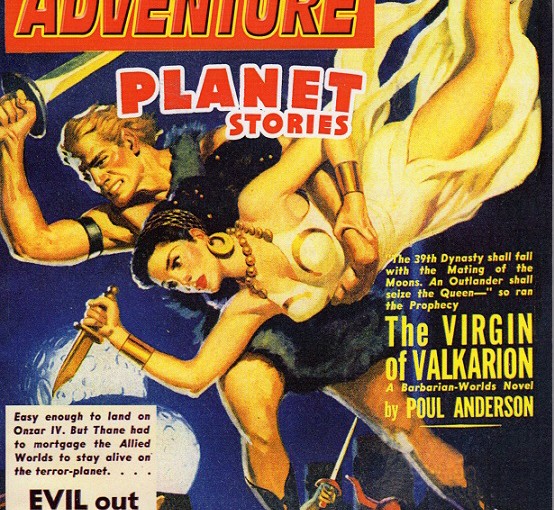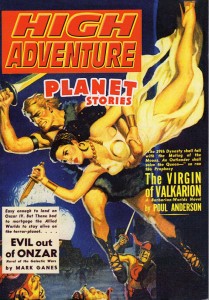Magazine Review: High Adventure #143: Planet Stories Issue edited by John P. Gunnison
Planet Stories was a science-fiction pulp magazine published between 1939 and 1955; it specialized in interplanetary action and daring-do. (See my review of Planet Comics, its sister magazine that started publishing about the same time. Covers tended to the formula of busty, scantily-clad (by the standards of the time) woman, handsome hero and bug-eyed monster.
The stories in this reprint are from 1951 & 1952, by which time the general quality of the stories had improved and science fiction itself was trending towards more mature writing. Most of the SF pulps that survived did so by switching to a digest format on somewhat better paper; Planet Stories was unable to make that transition.
“Zero Data” by Charles Saphro is a bit different from the usual for the magazine in that while interplanetary travel exists, it takes place on Earth. Police officer Jason has been trying to get the goods on crimelord Lonnie Raichi for years. But no matter what new crime-fighting equipment the police labs produce, Lonnie always escapes detection. By 2009, he’s become THE Launcelot Raichi and the higher-ups of Government City are putting heavy pressure on Captain Jason to simply stop investigating.
Lonnie ascribes his success to his “Triple Ethic”, one of the tenets of which is paying the right people to produce solutions to his problems. For example, the head inventor of the police labs was on his payroll, creating ways to beat the latest anti-crime technology before delivering that technology to the police.
Captain Jason has the last laugh, however, figuring out what Lonnie is after, and using the low-tech approach of being there in person with his human eyes. He’s realized that Lonnie has never bothered learning the scientific principles his crime suit operates on.
“Thompson’s Cat” by Robert Moore Williams demonstrates the wisdom of bringing a housecat on your rocketship. An exploration crew finds a planet devoid of life, looking like everyone died in a sudden attack by unknown enemies, but with no radioactivity or battle damage to the buildings. On the way back to Earth, crew members start dying of something that turns their skin green. The captain locks the ship into a course for the sun–if they can’t figure out the cause before they fry, at least Earth won’t be contaminated. A fairly simple puzzle story, though raising some questions about the alien life cycles.
“The Slaves of Venus” by Edwin James is closer to the traditional “planetary romance” formula Planet Stories was known for. A political figure exiled from Earth and Mars arrives on Venus to free it from the tyrannical interplanetary government. Except that he himself is one of the former dictators who has been overthrown. The actual hero unites Venus’ barbarian tribes to stop the slave trade and has a romance with the dictator’s naive daughter who bought into her father’s narrative.
“Evil Out of Onzar” by Mark Ganes has a shapeshifting intelligence officer assigned to bodyguard a scientist who has developed a new wrinkle on hyperspace travel that would make it easier for one side of the galactic war to win. He fails, but manages to hook up with the scientist’s lovely daughter, herself a brilliant scientist (Planet tended to have pretty competent heroines who were of actual use to the hero once he saved them.) Onzar turns out to be an important choke point in the hyperspace system, and an ideal place for an ambush. Unfortunately, it’s run by a dictator who is himself bent on conquest.
The best character in the story is Pyuf, an amiable and hard-drinking fellow who has many jobs, not all of them legitimate. Sadly, he leaves the tale about halfway through. There’s also an interesting social divide between gold-obsessed males and religious females on Onzar.
“The Virgin of Valkarion” by Poul Anderson is in the “Barbarian Worlds” setting. Humanity went to the stars, but the planets became cut off from each other and fell into more primitive societies. Eons have passed since then. Alfric, an outlander, comes to Valkarion, last vestige of an empire that once ruled the planet back when it had oceans. He’s directed to a particular tavern, and the girl that comes with his room is of far too high quality to be an ordinary prostitute.
Turns out she’s Hildaborg, queen of Valkarion, whose husband just died–there’s a prophecy that Alfric fits to an uncomfortable degree, and she wants in on the ground floor. The priest Therokos, on the other hand, wants to break the prophecy and rule himself. (The title is a lie. There is no virgin in the story.)
This could easily be fantasy; the only hints of SF are the alien planet thing and hints that Alfric’s sword is technological in nature.
“The Big Pill” by Raymond Z. Gallun finishes the issue with a colony on Titan. It’s just suffered a tragedy due to defective equipment shipped in by Space Colonists’ Supply, Inc. The current owner values profit over safety, and has blocked more modern equipment from being imported thanks to his monopoly. Some of the colonists have a plan to make conditions on Titan better…using a descendant of the hydrogen bomb. They must work against the clock as the corporate jerk is determined to see them all under his thumb instead.
Overall, this is a fun issue for pulp SF fans, which is better on the sexism front than much of the contemporary material. (There’s some Mighty Whitey moments in “The Slaves of Venus” that may be off-putting.)


